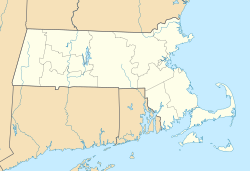Top Qs
Timeline
Chat
Perspective
Hope Cemetery (Worcester, Massachusetts)
Historic cemetery in Massachusetts, United States From Wikipedia, the free encyclopedia
Remove ads
Hope Cemetery is an historic rural cemetery at 119 Webster Street in Worcester, Massachusetts. Established in 1854, it was the city's sixth public cemetery, and is the burial site of remains originally interred at its first five cemeteries. Its landscaping and funerary art are examplars of the rural cemetery movement, and the cemetery was listed on the National Register of Historic Places in 1997. The cemetery occupies 168 acres (68 ha).[2]
Remove ads
Description and history
Summarize
Perspective
Hope Cemetery is located in far southern Worcester, atop a rise known as Webster Hill, which has commanding views to the north and east, including the campuses of Clark University and the College of the Holy Cross. The cemetery was laid out, probably by a landscape designer (although none has been identified), in the rural cemetery style, with winding lanes that take advantage of the terrain. It also includes horticultural plantings of note, another hallmark of the rural cemetery style, including several distinguished specimens of beech, Norway maple, sugar maple, cedar, ash, and oak trees.[3]
Worcester's first burying ground was located at Thomas and Summer Streets, and was established in 1713, and had seventeen graves marked by stone mounds, and the second burying ground, located on the Worcester Common, had more than 100 burials, all of which were relocated here in the 20th century. The third burying ground, Raccoon Plain, was a small cemetery with sixteen burials, all of which were reinterred here in 1857. The fourth burying ground, at Mechanic Street, had more than 1000 burials, which were moved here in 1878–79. The Pine Meadow Burying Ground's 658 interments were relocated here between 1862 and 1878.[3]
Remove ads
Notable interments
- Agnes Ballard, architect, educator, one of the first women elected to office in Florida
- Elizabeth Bishop, poet[4]
- Loring Coes, inventor of the Monkey wrench
- Abby Kelley Foster, 19th century social reformer and feminist
- Stephen Symonds Foster, radical abolitionist
- Robert Goddard, engineer, inventor of the first liquid-fueled rocket[4]
- John Bartholomew Gough, temperance lecturer
- Iver Johnson, firearm, bicycle and motorcycle manufacturer[4]
- Charles H. Pinkham, Medal of Honor recipient
- Thomas Plunkett, Medal of Honor recipient
- Capt. Peter Slater, youngest participant in the Boston Tea Party, fought in the American Revolution
- Amy Tanner, psychologist at Clark University[5]
- Eli Thayer, Congressman
- Webster Thayer, trial judge in the Sacco and Vanzetti case
Remove ads
See also
References
External links
Wikiwand - on
Seamless Wikipedia browsing. On steroids.
Remove ads



